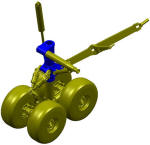Please visit the following websites if you are
interested to get more information about landing gears:
1.
Messier-Dowty
2.
BF Goodrich
Chapter 32 Landing Gear
The landing of an
aircraft is usually explained
as no more than an aircraft crash
controlled event.
There are different
landing gear designs. The design and location of the landing gear is
determined by the characteristics of each aircraft, i.e, geometry,
weight.
Weight of the aircraft
in addition to the MTOW (Maximum Take Off Weight) and MLW (Maximum
Landing Weight) are essential factors in the decision in the design of
the landing gear. These
factors determine the number and size of tires, the type of wheels and
brakes, the shock absorber.
When the aircraft
manufacturer is designing the landing gear, they have to obey some
industry and federal standards.
There have been some landing gear changes when a new series in a
model aircraft has been introduced in the market.
The DC 10-10 only had
one nose gear and two main gears as the initial configuration.
The introduction of the later DC 10 model, the DC 10-30, required
the addition of another gear in the configuration of this airplane. The
centerline gear maintains this airplane stable on the ground and aids in
the balance and proper distribution of the increase of the payload on
the Dc 10-30 model. The inclusion of the centerline gear on the DC 10-30
reduced the risk of loading and unloading the wrong way and making it
tail heavy. Some accidents happened during the unloading and loading of
this aircraft.
Another change in gear
design from one model to another was the one done on the Airbus
A300/A310 with the introduction of LaGuardia landing gear design.
Messier-Dowty the manufacturer of the landing gears for the A300/A310
had to develop a landing gear with bigger print for better weight
distribution in order for the New York airport authorities to allow the
airplane to land in La Guardia airport.
This page also
includes some pictures of the
JetBlue 90 degree landing gear
incident. I
was involved in the inspection and part of the investigation of this
landing gear. After the investigation several recommendations and
modifications were made to the landing gear. One recommendation adopted
was the decrease the number of times the computer check the alignment
(lock in place straight attitude) of the nose landing gear. The computer
was programmed to check the gear lock down position each second. The
computer sent signals to the steering actuator,RVDTs to apply forces to
the shock absorber to ensure the shock absorber was still locked down in
position. Each airline has
different policies for the extension of landing gear during approach. In
the event an airline had as a policy to extend the gears three minutes
before landing that means the computer in the A320 would have applied
forces to the shock absorber 180 times! In the case of the JetBlue
landing gear it was adopted to decrease those checks in flight to reduce
the risk of stress raises (cracks) and to modify the top part of the
absorber of the landing gear to make it idiot proof. This particular
gear was re-assembled incorrectly. I believe it took more than 10
landings before the landing gear failed.
The landing gear did
its job and avoided a fatal event. By the way, the main housing in this
gear is made out of a special aluminum to reduce weight on the aircraft
